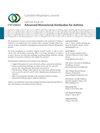Anti-Myxovirus Resistance Protein-1 Immunoglobulin A Autoantibody in Idiopathic Pulmonary Fibrosis
IF 2.1
4区 医学
Q3 RESPIRATORY SYSTEM
引用次数: 0
Abstract
Background We have previously analysed serum autoantibody levels in patients with idiopathic pulmonary fibrosis (IPF), idiopathic nonspecific interstitial pneumonia (iNSIP), and healthy controls and identified the autoantibody against anti-myxovirus resistance protein-1 (MX1) to be a specific autoantibody in iNSIP. We found that a higher anti-MX1 autoantibody level was a significant predictor of a good prognosis in patients with non-IPF idiopathic interstitial pneumonias. In this retrospective study, we sought to clarify the prognostic significance of the anti-MX1 autoantibody in IPF. Methods We measured anti-MX1 immunoglobulin (Ig) G, IgA, and IgM autoantibody levels by enzyme-linked immunosorbent assay in serum collected at the time of diagnosis from 71 patients with IPF diagnosed according to the 2018 IPF guideline. The gender-age-physiology (GAP) index was calculated in each case. Results The study population (59 men and 12 women) had a median age of 67 years. Serum anti-MX1 IgG and IgA autoantibody levels correlated positively with GAP stage (p < 0.05). Univariate Cox proportional hazards regression analysis did not identify an elevated anti-MX1 IgG, IgA, or IgM autoantibody level as a significant prognostic factor; however, a higher anti-MX1 IgA autoantibody level heralded significantly poorer survival after adjustment for GAP stage (p=0.030) and for percent forced vital capacity and modified Medical Research Council score (p=0.018). Neither the anti-MX1 IgG autoantibody nor the IgM autoantibody could predict survival after these adjustments. Conclusions The serum anti-MX1 IgA autoantibody level is a significant prognostic factor in IPF. Further studies are needed to clarify the pathophysiological role of this autoantibody in IPF.特发性肺纤维化中的抗粘液病毒耐药性蛋白-1免疫球蛋白A自身抗体
背景我们先前分析了特发性肺纤维化(IPF)、特发性非特异性间质性肺炎(iNSIP)患者和健康对照组的血清自身抗体水平,并确定抗粘病毒抵抗蛋白-1(MX1)的自身抗体是iNSIP中的一种特异性自身抗体。我们发现,在非IPF特发性间质性肺炎患者中,较高的抗MX1自身抗体水平是良好预后的重要预测因素。在这项回顾性研究中,我们试图阐明抗MX1自身抗体在IPF中的预后意义。方法我们通过酶联免疫吸附试验测定了71例根据2018年IPF指南诊断的IPF患者在诊断时收集的血清中的抗MX1免疫球蛋白(Ig)G、IgA和IgM自身抗体水平。计算每个病例的性别年龄生理学(GAP)指数。结果研究人群(59名男性和12名女性)的中位年龄为67岁。血清抗MX1 IgG和IgA自身抗体水平与GAP分期呈正相关(p<0.05)。单变量Cox比例风险回归分析未发现抗MX1 IgG、IgA或IgM自身抗体水平升高是一个重要的预后因素;然而,较高的抗MX1-IgA自身抗体水平预示着在调整GAP分期(p=0.030)、强迫肺活量百分比和改良医学研究委员会评分(p=0.018)后的生存率显著降低。抗MX1-IgG自身抗体和IgM自身抗体都不能预测这些调整后的生存。结论血清抗MX1 IgA自身抗体水平是影响IPF预后的重要因素。需要进一步的研究来阐明这种自身抗体在IPF中的病理生理作用。
本文章由计算机程序翻译,如有差异,请以英文原文为准。
求助全文
约1分钟内获得全文
求助全文
来源期刊

Canadian respiratory journal
医学-呼吸系统
CiteScore
4.20
自引率
0.00%
发文量
61
审稿时长
6-12 weeks
期刊介绍:
Canadian Respiratory Journal is a peer-reviewed, Open Access journal that aims to provide a multidisciplinary forum for research in all areas of respiratory medicine. The journal publishes original research articles, review articles, and clinical studies related to asthma, allergy, COPD, non-invasive ventilation, therapeutic intervention, lung cancer, airway and lung infections, as well as any other respiratory diseases.
 求助内容:
求助内容: 应助结果提醒方式:
应助结果提醒方式:


